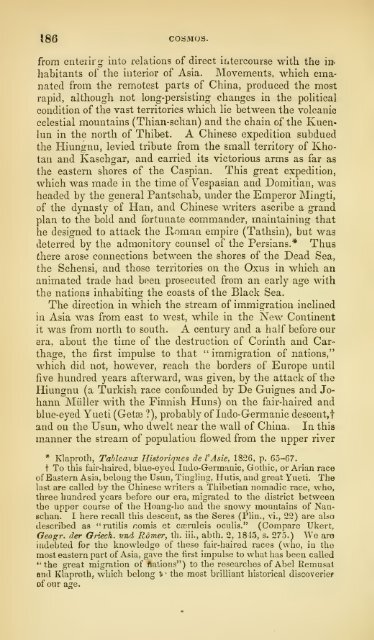See the complete document here
See the complete document here
See the complete document here
You also want an ePaper? Increase the reach of your titles
YUMPU automatically turns print PDFs into web optimized ePapers that Google loves.
J 86<br />
COSMOS.<br />
from enterirg into relations of direct iiitercourse with <strong>the</strong> hr<br />
habitants of <strong>the</strong> interior of Asia. Movements, which emanated<br />
from <strong>the</strong> remotest parts of China, produced <strong>the</strong> most<br />
rapid, although not long-persisting changes in <strong>the</strong> political<br />
condition of <strong>the</strong> vast territories which lie between <strong>the</strong> volcanic<br />
celestial mountains (Thian-scllan) and <strong>the</strong> chain of <strong>the</strong> Kuenlun<br />
in <strong>the</strong> north of Thibet. A Chinese expedition subdued<br />
<strong>the</strong> Hiungnu, levied tribute from <strong>the</strong> small territory of Khotan<br />
and Kaschgar, and carried its victorious arms as far as<br />
<strong>the</strong> eastern shores of <strong>the</strong> Caspian. This great expedition,<br />
which was made in <strong>the</strong> time of Vespasian and Domitian, was<br />
headed by <strong>the</strong> general Pantschab, under <strong>the</strong> Emperor Mingti,<br />
of <strong>the</strong> dynasty of Han, and Chinese writers ascribe a grand<br />
plan to <strong>the</strong> bold and fortunate commander, maintaining that<br />
he designed to attack <strong>the</strong> Roman empire (Tathsin), but was<br />
deterred by <strong>the</strong> admonitory counsel of <strong>the</strong> Persians.* Thus<br />
<strong>the</strong>re arose connections between <strong>the</strong> shores of <strong>the</strong> Dead Sea,<br />
<strong>the</strong> Schensi, and those territories on <strong>the</strong> Oxus in which an<br />
animated trade had been prosecuted from an early age with<br />
<strong>the</strong> nations inhabiting <strong>the</strong> coasts of <strong>the</strong> Black Sea.<br />
The direction in which <strong>the</strong> stream of immigration inclined<br />
in Asia was from east to west, while in <strong>the</strong> New Continent<br />
it was from north to south. A century and a half before our<br />
era, about <strong>the</strong> time of <strong>the</strong> destruction of Corinth and Car-<br />
thage, <strong>the</strong> first impulse to that " immigration of nations,"<br />
which did not, however, reach <strong>the</strong> borders of Europe until<br />
five hundred years afterward, was given, by <strong>the</strong> attack of <strong>the</strong><br />
Hiungnu (a Turkish race confounded by De Guignes and Johann<br />
Mliller with <strong>the</strong> Finnish Huns) on <strong>the</strong> fair-haired and<br />
blue-eyed Yueti (Getse ?), probably of Indo-Germanic descent,!<br />
and on <strong>the</strong> Usun, who dwelt near <strong>the</strong> wall of China. In this<br />
manner <strong>the</strong> stream of population flowed from <strong>the</strong> upper river<br />
*<br />
Klaprotb, Tableaux Historiques de V Asia, 1826, p. 65-67.<br />
t To this fair-haired, blue-eyed Indo-Germanic, Gothic, or Arian race<br />
of Eastern Asia, belong <strong>the</strong> Usun, Tingling, Hutis, and great Yueti. The<br />
last are called by <strong>the</strong> Chinese writers a Thibetian nomadic i-ace, who,<br />
three hundred years before our era, migrated to tlie district between<br />
<strong>the</strong> upper course of <strong>the</strong> Hoang-ho and <strong>the</strong> snowy mountains of Nan-<br />
Bchan. I <strong>here</strong> recall this descent, as <strong>the</strong> Seres (Plin., vi., 22) are also<br />
described as "rutilis r;omis et cseruleis oculis." (Compare Ukert,<br />
Geogr. der Oriech. nnd Romer, th. iii., abth. 2, 1845, s. 275.) We are<br />
indebted for <strong>the</strong> knowledge of <strong>the</strong>se fair-haired races (who, in <strong>the</strong><br />
most eastern part of Asia, gave <strong>the</strong> first impulse to what has been called<br />
"<strong>the</strong> great migration of ftations") to <strong>the</strong> researches of Abel Remusal<br />
and Klaproth, which belong b- <strong>the</strong> most brilliant historical discoverief<br />
of our age.
















